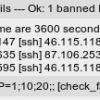Search Exchange
Search All Sites
Nagios Live Webinars
Let our experts show you how Nagios can help your organization.Login
Directory Tree
Directory
OldBlogger
In the header block it mentions a staus check being implemented which I think is where this came from at line 18
ps_state=$(ps aux |grep "fail2ban.sock" |grep -v grep| wc -l)
This seems to be an attempt to check if the fail2ban.sock socket has been created by the nagios-server, except this is looking at processes not sockets or at least it is on my Centos 7.7 installation, it always returns zero so the program aborts further down with the message
++++ Process is not running ++++
Change line 18 to this instead
ps_state=$(ss -aux |grep "fail2ban.sock" |grep -v grep| wc -l)
Basically use ss instead of ps and put the - before the aux
options.
Then it returns 1 as expected if the fail2ban-server is running and the script works correctly.
ps_state=$(ps aux |grep "fail2ban.sock" |grep -v grep| wc -l)
This seems to be an attempt to check if the fail2ban.sock socket has been created by the nagios-server, except this is looking at processes not sockets or at least it is on my Centos 7.7 installation, it always returns zero so the program aborts further down with the message
++++ Process is not running ++++
Change line 18 to this instead
ps_state=$(ss -aux |grep "fail2ban.sock" |grep -v grep| wc -l)
Basically use ss instead of ps and put the - before the aux
options.
Then it returns 1 as expected if the fail2ban-server is running and the script works correctly.
byOldBlogger, April 5, 2019

 Directory
Directory New Listings
New Listings
